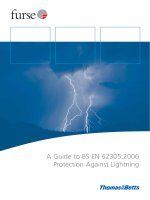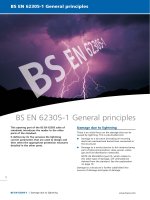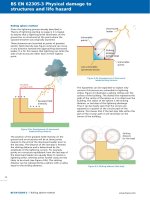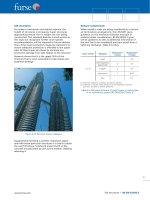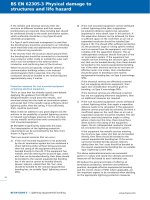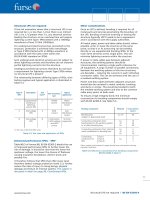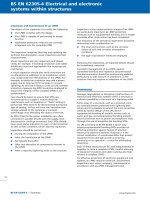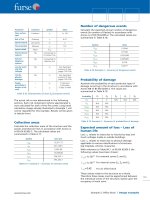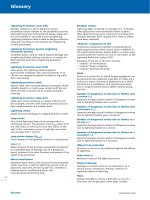Bsi bs en 00378 2 2016
Bạn đang xem bản rút gọn của tài liệu. Xem và tải ngay bản đầy đủ của tài liệu tại đây (2.42 MB, 90 trang )
BS EN 378-2:2016
BSI Standards Publication
Refrigerating systems and
heat pumps — Safety and
environmental requirements
Part 2: Design, construction, testing,
marking and documentation
BS EN 378-2:2016
BRITISH STANDARD
National foreword
This British Standard is the UK implementation of EN 378-2:2016. It
supersedes BS EN 378-2:2008+A2:2012 which is withdrawn.
The UK participation in its preparation was entrusted to Technical
Committee RHE/18, Refrigeration safety.
A list of organizations represented on this committee can be
obtained on request to its secretary.
This publication does not purport to include all the necessary
provisions of a contract. Users are responsible for its correct
application.
© The British Standards Institution 2016.
Published by BSI Standards Limited 2016
ISBN 978 0 580 84661 8
ICS 27.080; 27.200
Compliance with a British Standard cannot confer immunity from
legal obligations.
This British Standard was published under the authority of the
Standards Policy and Strategy Committee on 31 December 2016.
Amendments/corrigenda issued since publication
Date
Text affected
BS EN 378-2:2016
EN 378-2
EUROPEAN STANDARD
NORME EUROPÉENNE
EUROPÄISCHE NORM
November 2016
ICS 27.080; 27.200
Supersedes EN 378-2:2008+A2:2012
English Version
Refrigerating systems and heat pumps - Safety and
environmental requirements - Part 2: Design, construction,
testing, marking and documentation
Systèmes frigorifiques et pompes à chaleur - Exigences
de sécurité et d'environnement - Partie 2: Conception,
construction, essais, marquage et documentation
Kälteanlagen und Wärmepumpen Sicherheitstechnische und umweltrelevante
Anforderungen - Teil 2: Konstruktion, Herstellung,
Prüfung, Kennzeichnung und Dokumentation
This European Standard was approved by CEN on 3 September 2016.
CEN members are bound to comply with the CEN/CENELEC Internal Regulations which stipulate the conditions for giving this
European Standard the status of a national standard without any alteration. Up-to-date lists and bibliographical references
concerning such national standards may be obtained on application to the CEN-CENELEC Management Centre or to any CEN
member.
This European Standard exists in three official versions (English, French, German). A version in any other language made by
translation under the responsibility of a CEN member into its own language and notified to the CEN-CENELEC Management
Centre has the same status as the official versions.
CEN members are the national standards bodies of Austria, Belgium, Bulgaria, Croatia, Cyprus, Czech Republic, Denmark, Estonia,
Finland, Former Yugoslav Republic of Macedonia, France, Germany, Greece, Hungary, Iceland, Ireland, Italy, Latvia, Lithuania,
Luxembourg, Malta, Netherlands, Norway, Poland, Portugal, Romania, Slovakia, Slovenia, Spain, Sweden, Switzerland, Turkey and
United Kingdom.
EUROPEAN COMMITTEE FOR STANDARDIZATION
COMITÉ EUROPÉEN DE NORMALISATION
EUROPÄISCHES KOMITEE FÜR NORMUNG
CEN-CENELEC Management Centre: Avenue Marnix 17, B-1000 Brussels
© 2016 CEN
All rights of exploitation in any form and by any means reserved
worldwide for CEN national Members.
Ref. No. EN 378-2:2016 E
BS EN 378-2:2016
EN 378-2:2016 (E)
Contents
Page
European foreword....................................................................................................................................................... 5
Introduction .................................................................................................................................................................... 7
1
Scope .................................................................................................................................................................... 8
2
Normative references .................................................................................................................................... 8
3
Terms, definitions and abbreviated terms ......................................................................................... 12
4
Significant hazards ...................................................................................................................................... 13
5
5.1
5.1.1
5.1.2
5.2
5.2.1
5.2.2
5.3
5.3.1
5.3.2
5.3.3
5.3.4
Safety requirements .................................................................................................................................... 13
General safety and environmental requirements ............................................................................ 13
General ............................................................................................................................................................. 13
Hazards to persons, property and environment .............................................................................. 13
Safety requirements for components and piping ............................................................................. 13
General requirements ................................................................................................................................ 13
Specific requirements................................................................................................................................. 15
Miscellaneous components ...................................................................................................................... 16
Materials.......................................................................................................................................................... 16
Testing.............................................................................................................................................................. 18
Marking ............................................................................................................................................................ 20
Documentation.............................................................................................................................................. 20
6
6.1
6.2
6.2.1
6.2.2
6.2.3
6.2.4
6.2.5
6.2.6
6.2.7
6.2.8
6.2.9
6.2.10
6.2.11
6.2.12
6.2.13
6.2.14
6.2.15
6.2.16
6.2.17
6.3
6.3.1
6.3.2
6.3.3
6.3.4
6.4
Requirements for assemblies .................................................................................................................. 21
General ............................................................................................................................................................. 21
Design and construction ............................................................................................................................ 22
General ............................................................................................................................................................. 22
Determination of the maximum allowable pressure ...................................................................... 22
Piping................................................................................................................................................................ 25
Shut off devices ............................................................................................................................................. 30
Protection devices ....................................................................................................................................... 31
Application of protection devices .......................................................................................................... 31
Indicating and measuring instruments (monitoring) .................................................................... 39
Liquid slugging in compressors .............................................................................................................. 40
Electrical requirements ............................................................................................................................. 40
Protection against hot surfaces............................................................................................................... 40
Protection against moving parts ............................................................................................................ 40
Vibration and drop test .............................................................................................................................. 40
Transport test................................................................................................................................................ 43
Protection against fire and explosion hazards .................................................................................. 43
Requirements for ventilated enclosures ............................................................................................. 45
Electromagnetic compatibility and fields (EMC, EMF).................................................................... 45
Noise ................................................................................................................................................................. 46
Testing.............................................................................................................................................................. 46
Tests .................................................................................................................................................................. 46
Strength pressure test ................................................................................................................................ 46
Tightness test................................................................................................................................................. 47
Test of the complete refrigerating system before putting it into operation .......................... 49
Marking and documentation.................................................................................................................... 50
2
BS EN 378-2:2016
EN 378-2:2016 (E)
6.4.1
6.4.2
6.4.3
General ............................................................................................................................................................. 50
Marking ............................................................................................................................................................ 50
Documentation .............................................................................................................................................. 52
Annex A (normative) Additional requirements for refrigerating systems containing R-717 ....... 55
A.1
Systems with a refrigerant charge above 50 kg ................................................................................. 55
A.2
Systems with a refrigerant charge above 3 000 kg........................................................................... 55
A.3
Pumps ............................................................................................................................................................... 55
Annex B (normative) Determination of category for components and refrigerating system
assemblies ....................................................................................................................................................... 56
B.1
General ............................................................................................................................................................. 56
B.2
Classification of the refrigerant ............................................................................................................... 56
B.3
Determine the maximum allowable pressure of the assembly ................................................... 56
B.4
Determine the state (liquid or gas) of the refrigerant .................................................................... 56
B.5
Determination of category of components .......................................................................................... 56
B.5.1 General ............................................................................................................................................................. 56
B.5.2 Pressure vessels and piping...................................................................................................................... 56
B.5.3 Safety accessories ......................................................................................................................................... 60
B.5.4 Joining of pressure equipment ................................................................................................................ 60
B.6
Determination of category of the assembly ........................................................................................ 63
Annex C (normative) Requirements for intrinsic safety test ..................................................................... 64
C.1
General ............................................................................................................................................................. 64
C.2
Determination of the maximum pressure during abnormal operation ................................... 64
C.2.1
Determination of the pressure at the high pressure side (PHIS) ................................................. 64
C.2.2
Determination of the pressure at the low pressure side (PLIS) ................................................... 64
C.2.3
Determination of PHIS and PLIS for reversible heat pumps ........................................................... 65
C.3
Strength pressure test................................................................................................................................. 65
C.4
Test results...................................................................................................................................................... 65
Annex D (normative) List of significant hazards ............................................................................................ 66
Annex E (informative) Assessment of assemblies for compliance with directive
2014/68/EU .................................................................................................................................................... 67
Annex F (informative) Examples for arrangement of pressure relief devices in refrigerating
systems ............................................................................................................................................................. 68
Annex G (informative) Checklist for external visual inspection of the installation .......................... 71
Annex H (informative) Stress corrosion cracking ......................................................................................... 73
H.1
Introduction.................................................................................................................................................... 73
H.2
Stress corrosion in copper ........................................................................................................................ 73
H.3
Stress corrosion in steel ............................................................................................................................. 73
H.4
Factors that influence stress corrosion cracking .............................................................................. 74
3
BS EN 378-2:2016
EN 378-2:2016 (E)
H.4.1 General ............................................................................................................................................................. 74
H.4.2 Yield strength ................................................................................................................................................ 74
H.4.3 Temperature .................................................................................................................................................. 74
H.4.4 Oxygen content ............................................................................................................................................. 74
H.4.5 Water content ................................................................................................................................................ 74
H.4.6 Age of equipment ......................................................................................................................................... 74
H.4.7 Avoiding stress corrosion cracking ....................................................................................................... 75
H.4.8 Conclusions .................................................................................................................................................... 75
Annex I (informative) Leak simulation test for A2L, A2, A3, B2L, B2, B3 refrigerants .................... 76
Annex J (informative) Commissioning procedure ......................................................................................... 78
Annex K (informative) Information on effective ignition sources .......................................................... 79
Annex ZA (informative) Relationship between this European Standard and the Essential
Requirements of EU Directive 2014/68/EU ....................................................................................... 81
Annex ZB (informative) Relationship between this European Standard and the Essential
Requirements of EU Directive 2006/42/EC ....................................................................................... 83
Bibliography ................................................................................................................................................................. 85
4
BS EN 378-2:2016
EN 378-2:2016 (E)
European foreword
This document (EN 378-2:2016) has been prepared by Technical Committee CEN/TC 182
“Refrigerating systems, safety and environmental requirements”, the secretariat of which is held by DIN.
This European Standard shall be given the status of a national standard, either by publication of an
identical text or by endorsement, at the latest by May 2017, and conflicting national standards shall be
withdrawn at the latest by May 2017.
Attention is drawn to the possibility that some of the elements of this document may be the subject of
patent rights. CEN [and/or CENELEC] shall not be held responsible for identifying any or all such patent
rights.
This document supersedes EN 378-2:2008+A2:2012.
This document has been prepared under a mandate given to CEN by the European Commission and the
European Free Trade Association, and supports essential requirements of EU Directive(s).
For relationship with EU Directive(s), see informative Annexes ZA and ZB, which are integral parts of
this document.
EN 378 consists of the following parts under the general title “Refrigerating systems and heat pumps —
Safety and environmental requirements”:
— Part 1: Basic requirements, definitions, classification and selection criteria;
— Part 2: Design, construction, installing, testing, marking and documentation;
— Part 3: Installation site and personal protection;
— Part 4: Operation, maintenance, repair and recovery.
The main changes in part 2 with respect to the previous edition are listed below:
— Harmonization as far as possible with ISO 5149:2014 and ISO 817:2014;
— Harmonizing requirements with DIRECTIVE 2014/68/EU (PED), related to pressure and DIRECTIVE
2006/42/EC (MD).
Following detailed changes are worth noting:
— In 5.2.1, the application of harmonized standard for components has been clarified, by making the
note normative;
— The content of the former Table 3 has been integrated in 6.2.6.2, with necessary modifications of the
flow chart in Figure 1;
— Replacement of 6.2.2.3 with requirements related to pressure rise in case of external fire;
— Improvement 6.2.5.2.2, regarding electronic safety switching devices for limiting the pressure;
— Rearrangement of the transport and vibration tests formerly 6.2.12 and now 6.2.12 and 6.2.13;
5
BS EN 378-2:2016
EN 378-2:2016 (E)
— Modification of the explosion hazard requirements in 6.2.14 (formerly 6.2.13);
— Addition of Annex H on stress corrosion cracking, Annex I on leak simulation test, Annex J on
commissioning procedure, Annex K on ignition sources;
— Modification of Annex ZA for harmonization with DIRECTIVE 2014/68/EU (PED);
— Deletion of Annex ZB and the update of Annex ZC (now new Annex ZB).
According to the CEN/CENELEC Internal Regulations, the national standards organizations of the
following countries are bound to implement this European Standard: Austria, Belgium, Bulgaria,
Croatia, Cyprus, Czech Republic, Denmark, Estonia, Finland, Former Yugoslav Republic of Macedonia,
France, Germany, Greece, Hungary, Iceland, Ireland, Italy, Latvia, Lithuania, Luxembourg, Malta,
Netherlands, Norway, Poland, Portugal, Romania, Slovakia, Slovenia, Spain, Sweden, Switzerland,
Turkey and the United Kingdom.
6
BS EN 378-2:2016
EN 378-2:2016 (E)
Introduction
The introduction of EN 378-1 is applicable.
This standard is a type C standard as stated in EN ISO 12100.
The machinery concerned and the extent to which hazards, hazardous situations and hazardous events
are covered are indicated in the scope of this standard.
When provisions of this type C standard are different from those which are stated in type A or B
standards, the provisions of this type C standard take precedence over the provisions of the other
standards, for machines that have been designed and built according to the provisions of this type C
standard.
7
BS EN 378-2:2016
EN 378-2:2016 (E)
1 Scope
This European Standard specifies the requirements for the safety of persons and property, provides
guidance for the protection of the environment and establishes procedures for the operation,
maintenance and repair of refrigerating systems and the recovery of refrigerants.
The term “refrigerating system” used in this European Standard includes heat pumps.
This Part 2 of this Standard is applicable to the design, construction and installation of refrigerating
systems including piping, components and materials. It includes ancillary equipment not covered in
EN 378-1, EN 378-3 or EN 378-4 which is directly associated with these systems. It also specifies
requirements for testing, commissioning, marking and documentation. Requirements for secondary
heat transfer circuits are excluded except for any protection requirements associated with the
refrigerating system. Ancillary equipment includes, for example, fans, fan motors, electrical motors and
transmission assemblies for open compressor systems.
This standard applies:
a) to refrigerating systems, stationary or mobile, of all sizes except to vehicle air conditioning systems
covered by a specific product standard, e.g. ISO 13043;
b) to secondary cooling or heating systems;
c) to the location of the refrigerating systems;
d) to replaced parts and added components after adoption of this standard if they are not identical in
function and in the capacity.
Systems using refrigerants other than those listed in EN 378-1:2016, Annex E are not covered by this
standard.
This standard does not apply to goods in storage.
This standard is not applicable to refrigerating systems which were manufactured before the date of its
publication as a European Standard except for extensions and modifications to the system which were
implemented after publication.
This standard is applicable to new refrigerating systems, extensions or modifications of already existing
systems, and for existing stationary systems, being transferred to and operated on another site.
This standard also applies in the case of the conversion of a system to another refrigerant type, in which
case conformity to the relevant clauses of parts 1 to 4 of the standard shall be assessed.
2 Normative references
The following documents, in whole or in part, are normatively referenced in this document and are
indispensable for its application. For dated references, only the edition cited applies. For undated
references, the latest edition of the referenced document (including any amendments) applies.
EN 378-1:2016, Refrigerating systems and heat pumps — Safety and environmental requirements — Part
1: Basic requirements, definitions, classification and selection criteria
EN 378-3:2016, Refrigerating systems and heat pumps — Safety and environmental requirements — Part
3: Installation site and personal protection
EN 378-4, Refrigerating systems and heat pumps — Safety and environmental requirements — Part 4:
Operation, maintenance, repair and recovery
8
BS EN 378-2:2016
EN 378-2:2016 (E)
EN 809, Pumps and pump units for liquids — Common safety requirements
EN 837-1:1996, Pressure gauges — Part 1: Bourdon tube pressure gauges — Dimensions, metrology,
requirements and testing
EN 837-2:1997, Pressure gauges — Part 2: Selection and installation recommendations for pressure
gauges
EN 837-3:1996, Pressure gauges — Part 3: Diaphragm and capsule pressure gauges — Dimensions,
metrology, requirements and testing
EN 1012-3, Compressors and vacuum pumps — Safety requirements — Part 3: Process compressors
EN 1092-1, Flanges and their joints — Circular flanges for pipes, valves, fittings and accessories, PN
designated — Part 1: Steel flanges
EN 1092-3:2003, Flanges and their joints — Circular flanges for pipes, valves, fittings and accessories, PN
designated — Part 3: Copper alloy flanges
EN 1736:2008, Refrigerating systems and heat pumps — Flexible pipe elements, vibration isolators,
expansion joints and non-metallic tubes — Requirements, design and installation
EN 1861:1998, Refrigerating systems and heat pumps — System flow diagrams and piping and
instrument diagrams — Layout and symbols
EN 12178:2003, Refrigerating systems and heat pumps — Liquid level indicating devices — Requirements,
testing and marking
EN 12263:1998, Refrigerating systems and heat pumps — Safety switching devices for limiting the
pressure — Requirements and tests
EN 12284:2003, Refrigerating systems and heat pumps — Valves — Requirements, testing and marking
EN 12693:2008, Refrigerating systems and heat pumps — Safety and environmental requirements —
Positive displacement refrigerant compressors
EN 12735-1, Copper and copper alloys — Seamless, round tubes for air conditioning and refrigeration —
Part 1: Tubes for piping systems
EN 12735-2, Copper and copper alloys - Seamless, round tubes for air conditioning and refrigeration - Part
2: Tubes for equipment
EN 12799:2000, Brazing — Non-destructive examination of brazed joints
EN 13136:2013, Refrigerating systems and heat pumps — Pressure relief devices and their associated
piping — Methods for calculation
EN 13313:2010, Refrigerating systems and heat pumps — Competence of personnel
EN 13445-1:2014, Unfired pressure vessels — Part 1: General
EN 13445-2:2014, Unfired pressure vessels — Part 2: Materials
EN 13445-3:2014, Unfired pressure vessels — Part 3: Design
9
BS EN 378-2:2016
EN 378-2:2016 (E)
EN 13445-4:2014, Unfired pressure vessels — Part 4: Fabrication
EN 13445-5:2014, Unfired pressure vessels — Part 5: Inspection and testing
EN 13445-6:2014, Unfired pressure vessels — Part 6: Requirements for the design and fabrication of
pressure vessels and pressure parts constructed from spheroidal graphite cast iron
EN 13445-8:2014, Unfired pressure vessels — Part 8: Additional requirements for pressure vessels of
aluminium and aluminium alloys
EN 13480-1:2012, Metallic industrial piping — Part 1: General
EN 13480-2:2012, Metallic industrial piping — Part 2: Materials
EN 13480-3:2012, Metallic industrial piping — Part 3: Design and calculation
EN 13480-4:2012, Metallic industrial piping — Part 4: Fabrication and installation
EN 13480-5:2012, Metallic industrial piping — Part 5: Inspection and testing
EN 13480-6:2012, Metallic industrial piping — Part 6: Additional requirements for buried piping
EN 13480-8:2012, Metallic industrial piping — Part 8: Additional requirements for aluminium and
aluminium alloy piping
EN 14276-1:2006+A1:2011, Pressure equipment for refrigerating systems and heat pumps — Part 1:
Vessels — General requirements
EN 14276-2:2007+A1:2011, Pressure equipment for refrigerating systems and heat pumps — Part 2:
Piping — General requirements
EN 16084:2011, Refrigerating systems and heat pumps — Qualification of tightness of components and
joints
EN 60079-15:2010, Explosive atmospheres — Part 15: Equipment protection by type of protection "n"
(IEC 60079-15:2010)
EN 60204-1:2006, Safety of machinery — Electrical equipment of machines — Part 1: General
requirements (IEC 60204-1:2005, modified)
EN 60335-1:2012, Household and similar electrical appliances — Safety — Part 1: General requirements
(IEC 60335-1:2010, modified)
EN 60335-2-24:2010, Household and similar electrical appliances — Safety — Part 2-24: Particular
requirements for refrigerating appliances, ice-cream appliances and ice makers (IEC 60335-2-24:2010)
EN 60335-2-34:2013, Household and similar electrical appliances — Safety — Part 2-34: Particular
requirements for motor-compressors (IEC 60335-2-34:2012)
EN 60335-2-40:2003, Household and similar electrical appliances — Safety — Part 2-40: Particular
requirements for electrical heat pumps, air-conditioners and dehumidifiers (IEC 60335-2-40:2002)
10
BS EN 378-2:2016
EN 378-2:2016 (E)
EN 60335-2-89:2010, Household and similar electrical appliances — Safety — Part 2-89: Particular
requirements for commercial refrigerating appliances with an incorporated or remote refrigerant
condensing unit or compressor (IEC 60335-2-89:2010)
EN 61000-6-1:2007, Electromagnetic compatibility (EMC) — Part 6-1: Generic standards — Immunity for
residential, commercial and light-industrial environments (IEC 61000-6-1:2005)
EN 61000-6-2:2005, Electromagnetic compatibility (EMC) — Part 6-2: Generic standards — Immunity for
industrial environments (IEC 61000-6-2:2005)
EN 61000-6-3:2007, Electromagnetic compatibility (EMC) — Part 6-3: Generic standards — Emission
standard for residential, commercial and light-industrial environments (IEC 61000-6-3:2006)
EN 61000-6-4:2007, Electromagnetic compatibility (EMC) — Part 6-4: Generic standards — Emission
standard for industrial environments (IEC 61000-6-4:2006)
EN ISO 3744:2010, Acoustics — Determination of sound power levels and sound energy levels of noise
sources using sound pressure — Engineering methods for an essentially free field over a reflecting plane
(ISO 3744:2010)
EN ISO 3746:2010, Acoustics — Determination of sound power levels and sound energy levels of noise
sources using sound pressure — Survey method using an enveloping measurement surface over a
reflecting plane (ISO 3746:2010)
EN ISO 4126-1:2013, Safety devices for protection against excessive pressure — Part 1: Safety valves (ISO
4126-1:2013)
EN ISO 4126-2:2003, Safety devices for protection against excessive pressure — Part 2: Bursting disc
safety devices (ISO 4126-2:2003)
EN ISO 4871:2009, Acoustics — Declaration and verification of noise emission values of machinery and
equipment (ISO 4871:1996)
EN ISO 6708:1995, Pipework components — Definition and selection of DN (nominal size) (ISO
6708:1995)
EN ISO 7010:2012, Graphical symbols — Safety colours and safety signs — Registered safety signs (ISO
7010:2011)
EN ISO 10675-1:2013, Non-destructive testing of welds — Acceptance levels for radiographic testing —
Part 1: Steel, nickel, titanium and their alloys (ISO 10675-1:2008)
EN ISO 10675-2:2013, Non-destructive testing of welds — Acceptance levels for radiographic testing —
Part 2: Aluminium and its alloys (ISO 10675-2:2010)
EN ISO 11202:2010, Acoustics — Noise emitted by machinery and equipment — Determination of
emission sound pressure levels at a work station and at other specified positions applying approximate
environmental corrections (ISO 11202:2010)
EN ISO 11688-1:2009, Acoustics — Recommended practice for the design of low-noise machinery and
equipment — Part 1: Planning (ISO/TR 11688-1:1995)
EN ISO 12100:2010, Safety of machinery — General principles for design — Risk assessment and risk
reduction (ISO 12100:2010)
11
BS EN 378-2:2016
EN 378-2:2016 (E)
EN ISO 13732-1:2008, Ergonomics of the thermal environment — Methods for the assessment of human
responses to contact with surfaces — Part 1: Hot surfaces (ISO 13732-1:2006)
EN ISO 13849-1:2015, Safety of machinery — Safety-related parts of control systems — Part 1: General
principles for design (ISO 13849-1:2015)
EN ISO 13850:2015, Safety of machinery — Emergency stop function — Principles for design (ISO
13850:2015)
EN ISO 13857:2008, Safety of machinery — Safety distances to prevent hazard zones being reached by
upper and lower limbs (ISO 13857:2008)
EN ISO 14120:2015, Safety of machinery — Guards — General requirements for the design and
construction of fixed and movable guards (ISO 14120:2015)
EN ISO 17636-1:2013, Non-destructive testing of welds — Radiographic testing — Part 1: X- and gammaray techniques with film (ISO 17636-1:2013)
EN ISO 17636-2:2013, Non-destructive testing of welds — Radiographic testing — Part 2: X- and gammaray techniques with digital detectors (ISO 17636-2:2013)
EN ISO 17638:2009, Non-destructive testing of welds — Magnetic particle testing (ISO 17638:2003)
EN ISO 17640:2010, Non-destructive testing of welds — Ultrasonic testing — Techniques, testing levels,
and assessment (ISO 17640:2010)
ISO 817:2014, Refrigerants — Designation and safety classification
ISO 13043:2011, Road vehicles — Refrigerant systems used in mobile air conditioning systems (MAC) —
Safety requirements
ASTM D 4728:2006, Standard Test Method for Random Vibration Testing of Shipping Containers
3 Terms, definitions and abbreviated terms
For the purposes of this document, the terms and definitions given in EN 378-1:2016 apply.
Designation, classification, and selected properties of the refrigerant such as:
— refrigerant number, e.g. R-717;
— safety classes A1, A2L, A2, A3, B1, B2L, B2, B3;
— lower flammability limits (LFL)
are specified in EN 378-1:2016, Annex E.
For the purposes of this document, abbreviated terms given in EN 378-1:2016 and the following apply.
DN Nominal size (see EN 378–1:2016, 3.5.14)
PS Maximum allowable pressure in bar (1 bar = 0,1 MPa) (see EN 378–1:2016, 3.3.2)
LFL Lower flammability limit in kg/m3 (see EN 378–1:2016, 3.7.8)
12
BS EN 378-2:2016
EN 378-2:2016 (E)
4 Significant hazards
The list of significant hazards related to the Machinery Directive is given in Annex D.
5 Safety requirements
5.1 General safety and environmental requirements
5.1.1 General
Safety and environmental requirements are specified for components and piping in 5.2 and 5.3 and for
assemblies in Clause 6.
Refrigerating appliances complying with product standards such as
— EN 60335-2-40 for electrical heat pumps, air-conditioners and dehumidifiers;
— EN 60335-2-24 for Particular requirements for refrigerating appliances, ice-cream appliances and
ice makers;
— EN 60335-2-89 for commercial refrigerating appliances with an incorporated or remote refrigerant
condensing unit or compressor
are in compliance with this European Standard up to and including category I as determined in Annex B,
provided they are also compliant with the applicable safety requirements for machinery or low voltage.
For refrigerating appliances of category II and higher, as determined in Annex B, the relevant
requirements for pressure safety in Clauses 5 and 6 apply.
5.1.2 Hazards to persons, property and environment
Refrigerating systems and components shall be designed and constructed with the intention to
eliminate possible hazards to persons, property and the environment. Deliberate discharge of
refrigerants shall only be permitted in a manner which is not harmful to persons, property and the
environment and in accordance with national laws.
5.2 Safety requirements for components and piping
5.2.1 General requirements
Components and piping shall comply with the related standards or requirements as indicated in
Table 1. Requirements for components not included in Table 1 and which are below category II as
defined in B.5 are indicated in 5.3.
Components that are declared to comply with the relevant directives using an alternative method also
comply with the requirements of this standard.
Where the product standards for components or piping are not harmonized for the EC provisions in
relation to pressure or if the essential requirements of such provisions are not covered, then the
relevant requirements for pressure shall be confirmed by risk assessment.
13
BS EN 378-2:2016
EN 378-2:2016 (E)
Table 1 — Components and piping requirements
COMPONENT
Heat exchangers:
— pipe coil without air (tube in tube)
— multi-tubular (shell and tubes)
related standard AND requirements
EN 14276–1 or EN 13445 if applicable combined with
5.2.2 of this standard
Plate heat exchangers
EN 14276–1 or EN 13445 if applicable combined with
5.2.2 of this standard
Receiver/accumulator/economizer
EN 14276–1 or EN 13445 if applicable combined with
5.2.2 of this standard
Drier
EN 14276–1 or EN 13445 if applicable combined with
5.2.2 of this standard
Headers, coils and grids with air as EN 14276–2 or EN 14276–1 if applicable combined
secondary fluid
with 5.2.2.2 of this standard
Oil separator
Filter
EN 14276–1 or EN 13445 if applicable combined with
5.2.2 of this standard
Muffler
Hermetic positive displacement motorcompressor
Semi-hermetic positive displacement
motor-compressor
Open positive displacement compressor
Non positive displacement compressor
Pump
Piping
general requirements
additional requirements for
pumps in refrigerating systems
and heat pumps with R-717
Piping joints: permanent joints
Piping joints: detachable joints
Flexible piping
Valves
general
isolating valves
hand operated valves
valves with seal cap
pressure relief valve
14
EN 14276–1 or EN 13445 if applicable combined with
5.2.2 of this standard
EN 14276–1 or EN 13445 if applicable combined with
5.2.2 of this standard
EN 14276–1, EN 60335–2-34 or EN 12693
EN 60335–2-34 or EN 12693
EN 12693
EN 14276–1, EN 1012–3 or EN 13445 if applicable
combined with EN 60204–1
EN 809 combined with EN 60204–1, and combined
with 5.2.2.2 and 5.2.2.4 of this standard
Annex A
EN 14276–2 or EN 13480
EN 14276–2
5.2.2.2 and 5.2.2.3 of this standard
EN 1736
EN 12284
EN 12284
EN 12284
EN 12284
EN 13136 and EN ISO 4126-1 combined with 5.2.2 of
BS EN 378-2:2016
EN 378-2:2016 (E)
COMPONENT
Safety switching devices for limiting the
pressure
Bursting disc
Liquid level indicators
Gauges
Brazing and soldering materials
Welding materials
related standard AND requirements
this standard
EN 12263 combined with 5.2.2.2 of this standard
EN ISO 4126-2 and EN 13136 combined with 5.2.2.2 of
this standard
EN 12178 combined with 5.2.2.2 of this standard
EN 837–1, EN 837–2 and EN 837–3 combined with
5.2.2.2 of this standard
5.3.1.3 e), f) of this standard
EN 14276–2
If the component contains electrical components, and if the component standard does not cover
electrical safety, then the component shall fulfil the electrical requirements of EN 60335-2-40,
EN 60335-2-24, EN 60335-2-89 or EN 60204-1 as relevant.
5.2.2 Specific requirements
5.2.2.1 General
In addition to the requirements of 5.2.1, the following requirements are applicable for incorporation of
specific components and piping into the refrigerating system.
5.2.2.2 Tightness
A tightness test shall be performed according to the type approval procedure as specified in EN 16084.
Unless otherwise agreed with the manufacturer of the assembly, components, not covered by the scope
of EN 16084, shall be tested with detection equipment having a sensitivity equivalent to 3 g/year of
refrigerant leakage or better, under a pressure of at least 0,25 × PS. The acceptance criterion is that no
leak shall be detected.
NOTE
This method may be specified in the components standard (see Table 1).
Clause 6 may require components incorporated in assemblies to conform to specified tightness control
levels according to EN 16084.
When agreed by the manufacturer of the assembly, some or all component tests may be included in the
assembly tests (refer to 6.3).
Tightness tests shall be conducted only after the component has passed a strength pressure test or has
been verified by a type test for strength pressure.
For environmental and safety reasons, nitrogen, helium, carbon dioxide or mixtures of low level
hydrogen are preferred test gases.
Radioactive tracers may be added to the test gases.
Air and gas mixtures should be avoided as certain mixtures can be dangerous. Air may be used if the
hazard of ignition is eliminated and worker safety is ensured. Oxygen shall not be used for tightness
tests.
15
BS EN 378-2:2016
EN 378-2:2016 (E)
5.2.2.3 Piping joints
Joints shall be designed so that they will not be damaged due to freezing of water on the outside. They
shall be suitable for the pipe, the piping material and the pressure, temperature and fluid.
Coated (e.g. galvanized) pipes shall not be welded, unless all coating has been completely removed from
the joint area. Welded joints shall be suitably protected.
5.2.2.4 Refrigerant liquid pumps
Refrigerant liquid pumps shall be provided with the following information as a minimum, which shall
be durable and permanently affixed:
a) manufacturer;
b) type designation;
c) serial number;
d) year of manufacture;
e) maximum allowable pressure (PS).
5.3 Miscellaneous components
5.3.1 Materials
5.3.1.1 General
The material of the component shall be suitable for the intended temperature and pressure range and
in combination with refrigerating systems as specified by the manufacturer of the refrigerating systems.
The material of the component shall conform to relevant standards.
Restrictions for use of dangerous or hazardous substances and preparations shall be taken into account.
NOTE
For example as required in EC/1907/2006 (REACH) and 2011/65/EU (RoHS).
5.3.1.2 Ferrous materials
a) Cast iron and malleable iron
Cast iron and malleable iron shall only be used, when suitable for the particular application in
accordance with the requirements of this standard.
NOTE 1
Since some grades of cast iron are brittle, their application is dependent on temperature, stress
and design considerations.
NOTE 2
Malleable iron has two general classifications with several different grades in each. These grades
can have very different mechanical properties.
b) Steel, cast steel, carbon steel and low alloy steel
Steel, cast steel, carbon steel and low alloy steel may be used for all components and piping in
contact with refrigerant or heat-transfer fluid. Where there is a combination of low temperatures
and high pressure, or where corrosion risks or thermal stresses are present, steel with adequate
impact strength shall be used taking into account its thickness, its lowest operating temperature
and its welding properties.
16
BS EN 378-2:2016
EN 378-2:2016 (E)
NOTE 3
Guidance on stress corrosion cracking in carbon steel is given in H.3.
c) High alloy steel
High alloy steel may be required where there is a combination of low temperatures and high
pressure, or where corrosion risks or thermal stresses are present. The impact strength shall be
adequate for the particular duty and the material suitable for welding, if required.
d) Stainless steel
When using stainless steel, care shall be taken to ensure that the grade of stainless steel is
compatible with the process fluids and possible atmospheric impurities, such as for example
sodium chloride (NaCl) or sulphuric acid (H2SO4).
5.3.1.3 Non-ferrous materials and their alloys (cast, forged, rolled and drawn)
a) Copper and copper alloys
Copper in contact with refrigerants shall be oxygen-free or de-oxidized, for example Cu-DHP as
specified in EN 12735-1 and EN 12735-2.
Copper and alloys with a high percentage of copper shall not be used for parts carrying R-717
unless their compatibility has been proved by test or experience.
NOTE 1
Guidance on stress corrosion cracking in copper pipe is given in H.2.
b) Aluminium and aluminium alloys
Aluminium used for gaskets for use with R-717 shall be of at least 99,5 % purity. Aluminium alloys
containing more than 2 % magnesium shall not be used with halogenated refrigerants unless their
compatibility has been proved by test or experience.
Methyl chloride (CH3Cl) shall not be used in contact with aluminium and its alloys.
NOTE 2
Aluminium and aluminium alloys may be used in any part of the refrigerant circuit provided that
its strength is adequate and it is compatible with the refrigerants and the lubricants being used.
c) Magnesium and magnesium alloys
Magnesium and magnesium alloys shall not be used unless their compatibility with refrigerants has
been proved by test or experience.
d) Zinc and zinc alloys
Zinc shall not be used in contact with R-717, except in electro zinc plated components.
Methyl chloride (CH3Cl) shall not be used in contact with zinc.
e) Soldering alloys
f)
Soldering alloys shall not be used for refrigerant containment purposes.
Brazing alloys
17
BS EN 378-2:2016
EN 378-2:2016 (E)
Brazing alloys shall not be used unless their compatibility with refrigerants and lubricants has been
proved by test or experience.
g) Tin and lead tin alloys
Tin and lead tin alloys may be corroded by halogenated refrigerants and shall not be used unless
their compatibility has been proved by test or experience.
NOTE 3
Copper free lead antimony or lead tin alloys may be used for valve seats.
5.3.1.4 Non-metallic materials
a) Gasket and packing materials
Gasket and packing materials for sealing joints and for sealing stuffing boxes on valves, etc. shall be
resistant to the refrigerants, oils and lubricants used and shall be suitable for the expected range of
pressures and temperatures.
NOTE See EN 16084.
b) Glass
Glass may be used in refrigerant circuits and for electrical terminal insulators, indicators and sight
glasses, but it shall be resistant to the pressures, temperatures and chemical actions which may
occur.
c) Asbestos
Asbestos shall not be used.
d) Plastics
When plastics are used, they shall be suitable for the mechanical, electrical, thermal, chemical and
long term creep conditions to which they are subjected.
e) Elastomers
When elastomers are used, they shall be suitable for the mechanical, electrical, thermal and
chemical conditions occurring, chemically and physically compatible with refrigerant or
refrigerant-oil mixtures with which they are in contact, and they shall not create fire hazards.
5.3.2 Testing
5.3.2.1 Tests
All the components shall undergo the following tests:
a) strength pressure test (refer to 5.3.2.2);
b) tightness test (refer to 5.2.2.2);
c) functional test.
The results of these tests shall be recorded. When agreed by the manufacturer of the assembly, some or
all tests may be conducted on the assembly (refer to 6.3).
18
BS EN 378-2:2016
EN 378-2:2016 (E)
5.3.2.2 Strength pressure test for miscellaneous components
5.3.2.2.1 General
The strength pressure test shall be one of the following methods:
— individual strength-pressure test according to 5.3.2.2.2, or
— strength-pressure type test according to 5.3.2.2.3, or
— fatigue test according to 5.3.2.2.4.
The test criteria specified in 5.3.2.2.5 shall apply.
5.3.2.2.2 Individual strength pressure test
Components shall be designed with a thickness according to standards of similar components of Table 1
and each component shall be strength pressure tested individually at a pressure which is no less than
1,43 × PS.
Preferably the strength pressure test shall be carried out by means of air or some other non-hazardous
gas. Adequate precautions shall be taken to prevent danger to people and to minimize risk to property.
A hydrostatic pressure test by means of water or some other liquid may be accepted under the
condition that the refrigeration circuit shall not be contaminated when the test is complete.
5.3.2.2.3 Strength pressure type test
Components shall be type tested at a test pressure value which is no less than 3 × PS.
If the continuous operating temperature of the component is less than or equal to
— 125 °C for copper or aluminium, or
— 200 °C for steel,
the test temperature of the component part or assembly shall be at least 20 °C.
If the continuous operating temperature of the component exceeds
— 125 °C for copper or aluminium, or
— 200 °C for steel,
the test temperature of the parts or assemblies that are at these temperatures, and subjected to the
pressure, shall be at least
— 150 °C for copper or aluminium and
— 260 °C for steel.
For other materials or higher temperatures, the effects of temperature on the material fatigue
characteristics shall be evaluated.
5.3.2.2.4 Fatigue test
Three test samples shall be subjected to a strength pressure test at a test pressure value not less than
2 × PS.
Three test samples, other than the samples used for the strength pressure test, shall be filled with fluid,
and shall be connected to a pressure-driving source. The pressure shall be raised and lowered between
19
BS EN 378-2:2016
EN 378-2:2016 (E)
the upper and lower cyclic values at a rate specified by the component manufacturer for a total number
of 250 000 cycles. The entire specified pressure excursion shall occur during each cycle. Pressure cycles
shall be between 20 cycles per minute and 60 cycles per minute.
For safety purposes, it is suggested that a non-compressible fluid should be used.
The following test pressures shall be applied:
For components at the low pressure side, PS of the low pressure side shall be applied for the first cycle.
For components at the high pressure side, PS of the high pressure side shall be applied for the first
cycle. The pressure of the test cycles shall be as follows:
— the upper pressure value shall not be less than 0,7 × PS and the lower pressure value shall not be
greater than 0,2 × PS. The upper pressure value shall not be less than 0,9 × PS for water heat
exchangers in heat pumps,
— for the final test cycle, the test pressure shall be increased to a pressure value not less than 1,4 × PS
(2 times 0,7 × PS). The pressure value shall not be less than 1,8 × PS (2 times 0,9 × PS) for water
heat exchangers in heat pumps
If the continuous operating temperature is less than or equal to
— 125 °C for copper or aluminium, or
— 200 °C for steel,
the test temperature of the component part or assembly shall be at least 20 °C.
If the continuous operating temperature of the component exceeds
— 125 °C for copper or aluminium, or
— 200 °C for steel,
the fatigue test temperature of the parts or assemblies that are at these temperatures, shall be at least
10 K above the continuous operating temperature.
Static test pressure shall be increased by the ratio of allowable stress of material at room temperature
to that at the highest continuous operating temperature.
For other materials, the effects of temperature on the fatigue characteristics shall be evaluated to
determine the test conditions.
5.3.2.2.5 Acceptance criteria
In the case of individual strength pressure test at minimum 1,43 × PS, permanent deformation shall not
result from this test.
In the case of strength pressure type test, the samples tested shall withstand a pressure not less than
3 × PS without rupture.
In the case of the fatigue test, the samples tested shall not rupture, burst, or leak after completion of this
test.
5.3.3 Marking
For miscellaneous components no special marking is required.
5.3.4 Documentation
The following documents for components shall be provided:
20
BS EN 378-2:2016
EN 378-2:2016 (E)
a) results of tests;
b) material test certificates shall be provided by the manufacturer as required by the purchaser to
enable him to ensure that the material used conforms with the required specification and that it is
traceable from the final test through production up to receipt, preferably at the time of delivery and
not later than the time of commissioning. Any required inspection certificate shall be prepared on
behalf of and signed by the competent person who carried out the inspection, test, or checking;
NOTE Material certificates type 2.1 or type 2.2 in accordance with EN 10204 can be provided.
c) documentation shall include the following specifications:
— maximum allowable pressure;
— maximum allowable temperature;
— applicable refrigerant;
— applicable oil.
6 Requirements for assemblies
6.1 General
The design, construction, testing, installing, documentation and marking of the refrigerating system
assembly shall comply with this clause.
Refrigerating system assemblies using R-717 as refrigerant shall also comply with the additional
requirements as specified in Annex A.
Determination of the category of the assembly shall be done in accordance with Annex B.
Refrigerating systems shall be charged with refrigerant at the manufacturing location or charged on site
as recommended by the manufacturer (see 6.4.3.2).
Constructional, welding and brazing materials shall be suitable to withstand foreseeable mechanical,
thermal and chemical stresses. They shall be compatible with the refrigerants, refrigerant and oil
mixtures (with possible impurities and contaminants) or the heat-transfer media.
Where components, joints or parts are described as hermetically sealed, they shall comply with the
requirements “hermetically sealed” according to EN 16084.
For hermetically sealed systems the use of non-metallic flexible hoses shall be limited to the following:
— The hoses shall be of class 1 according to EN 1736
— The total maximum length of the non-metallic flexible hoses installed on the system shall fulfil the
following formula:
∑ li × di × π ×10 g / m 2 year + ∑ l j × d j × π × 200 g / m 2 year < 1,5 g / year
where
li
is the length of the flexible hose in metres where the temperature of the
refrigerant is lower than or equal to 32 °C;
21
BS EN 378-2:2016
EN 378-2:2016 (E)
lj
di
dj
10 g/m2year
200 g/m2year
is the length of the flexible hose in metres where the temperature of the
refrigerant is higher than 32 °C;
is the internal diameter of the flexible hose in metres where the temperature of
the refrigerant is lower than or equal to 32 °C;
is the internal diameter of the flexible hose in metres where the temperature of
the refrigerant is higher than 32 °C;
is the allowable permeability at 32 °C for class 1 flexible hoses;
is the allowable permeability at 100 °C for class 1 flexible hoses.
6.2 Design and construction
6.2.1 General
All components selected for the assembly of the refrigerant circuit shall comply with Clause 5.
The supports and bases of refrigerating systems shall have sufficient strength to withstand external
forces for example:
a) the mass of the vessels;
b) the mass of the contents and equipment, including the mass of hydrostatic test fluid and the mass of
ice which may form under foreseeable abnormal operating circumstances;
c) the snow load;
d) the wind load;
e) the mass of stays, braces and interconnecting piping;
f)
the thermal movement of the piping and components;
g) the forces arising from foreseeable misuse;
The supports and bases of refrigerating systems installed in areas with possible risk of earthquakes
shall have sufficient strength to withstand the expected acceleration due to earthquakes.
The refrigerating system shall be equipped with sufficient service access ports as required for the
application.
6.2.2 Determination of the maximum allowable pressure
6.2.2.1 Maximum allowable pressure (PS)
The maximum allowable pressure shall be determined by taking into account factors such as:
a) the maximum ambient temperature;
b) the possible accumulation of non-condensable gases;
c) the setting of any pressure relief device;
d) the method of defrosting;
e) the application (e.g. cooling or heating application);
22
BS EN 378-2:2016
EN 378-2:2016 (E)
f)
solar radiation; (e.g. impact on ice rinks during standstill);
g) fouling;
h) transport conditions including those specified in 6.2.13.
Based on the relevant factors, the designer shall determine the maximum allowable pressures in the
different parts of the refrigerating system taking into account a maximum ambient temperature as
appropriate for the installation site.
One of the following methods shall be used to determine the maximum allowable pressure (PS) of the
different parts of the refrigerating system.
— Method 1
The designer shall document the calculation or testing method used for the determination of the
maximum allowable pressure. Where temperature differences between ambient temperature and
condensing temperature are calculated, the method shall be verified by testing.
For the low temperature circuit of a cascade system, the maximum allowable pressure PS shall be
determined by the designer. The designer shall make provision for standstill under all reasonably
foreseeable conditions.
— Method 2
Table 2 is an alternative to Method 1. The minimum value of the maximum allowable pressure shall
be determined by the minimum specified temperatures given in Table 2 to determine the saturated
refrigerant pressure. When the evaporators can be subject to high pressure e.g. during hot gas
defrosting or reverse cycle operation, the high pressure side specified temperature shall be used.
The use of specified temperatures does not always result in saturated refrigerant pressure within
the system. In the case of a limit charged system at standstill condition the isochoric behaviour
shall be regarded (refrigerant charge compared to free inner volume of the system). In case of
pressure stages operating above the critical point Method 1 shall be used.
23
